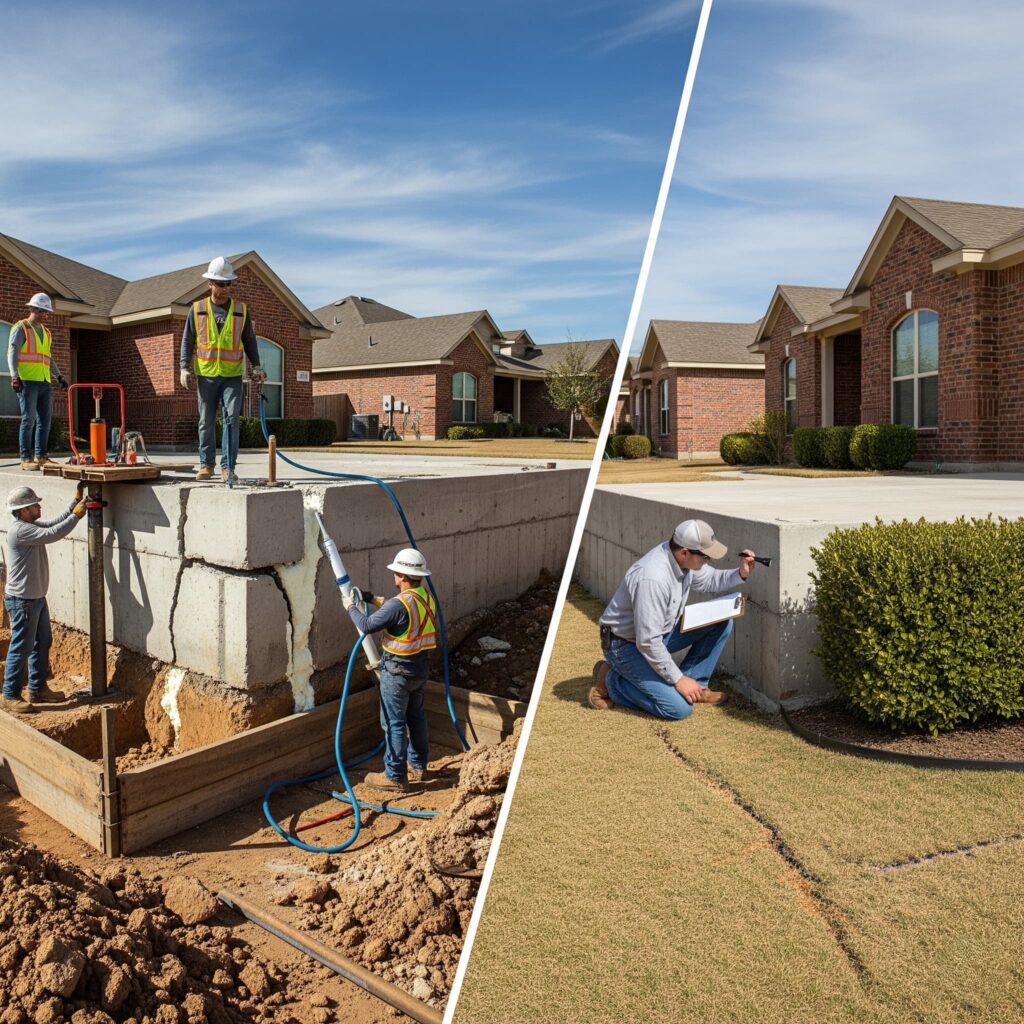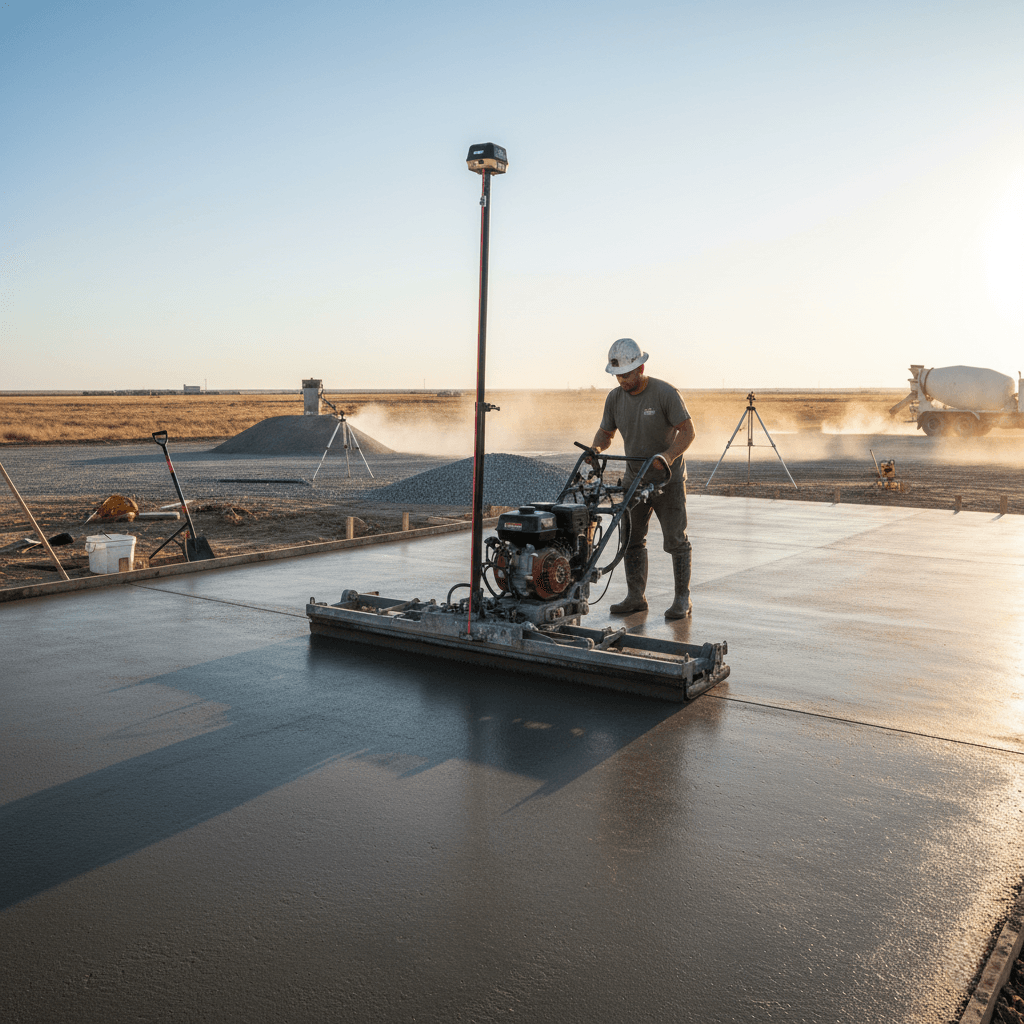
Concrete Foundation Repair: Emergency vs Routine Costs
Concrete Foundation Repair Midland
Understanding the critical differences between emergency and routine concrete foundation repair helps homeowners make informed decisions that protect both their property investment and family safety. Emergencies require immediate attention to prevent catastrophic failure, while routine maintenance addresses gradual wear that develops over time. Foundation repair in Midland, Texas, can range between $3,000-$5,000 or more, depending on the company and the project. Cost variations reflect different urgency levels, repair complexity, and material requirements that distinguish emergency interventions from planned maintenance activities. Professional assessment determines appropriate response levels while ensuring homeowners receive cost-effective solutions that address both immediate needs and long-term structural integrity throughout West Texas’s challenging soil conditions.

Identifying Emergency Foundation Issues
Emergency foundation problems pose immediate threats to structural integrity and require rapid professional intervention to prevent further damage or safety hazards. Horizontal cracks running along basement walls often indicate foundation settling or excessive soil pressure that demands urgent attention. These cracks can expand rapidly during weather changes or soil movement, potentially compromising load-bearing capacity.
Sudden changes in door and window operation, including difficulty opening or closing, gaps appearing around frames, or visible separation from wall surfaces, indicate active foundation movement. These symptoms often develop quickly during seasonal transitions when soil moisture content fluctuates dramatically in West Texas clay soils.
Water intrusion through foundation cracks, basement flooding, or sudden changes in basement humidity levels require immediate response to prevent structural damage, mold growth, and electrical hazards. Standing water around foundation perimeters combined with visible cracks signals urgent drainage and structural issues.
Dramatic floor elevation changes, visible sagging, or bouncing floors indicate potentially dangerous structural failures requiring emergency evaluation. These conditions affect both safety and habitability, demanding immediate professional assessment and intervention.
Areas near recreational destinations like Big Spring State Park, located about 40 miles from Midland, experience similar soil conditions that can create sudden foundation movement during extreme weather events. Understanding regional patterns helps homeowners recognize when gradual changes accelerate into emergencies.
Critical Warning Signs Requiring Immediate Action
Visible foundation movement, large cracks exceeding quarter-inch width, or gaps between foundation and structure indicate immediate danger requiring emergency response. Professional contractors prioritize these situations to prevent catastrophic failure or additional property damage.
Routine Maintenance and Preventive Care
Routine concrete foundation repair addresses gradual deterioration before problems escalate into emergencies. Regular maintenance includes minor crack sealing, drainage adjustments, and protective treatments that preserve foundation integrity while managing normal settlement and seasonal movement.
Small hairline cracks, minor settling, and cosmetic issues typically qualify for routine repair schedules that allow homeowners to plan timing and budget allocation. These problems develop slowly over months or years, providing opportunities for proactive intervention that prevents emergencies.
Annual foundation inspections identify developing issues before they become urgent problems. Professional assessment documents changes over time, enabling predictive maintenance that addresses problems during optimal weather conditions and contractor availability.
Routine drainage maintenance prevents water-related foundation problems that commonly escalate into emergency repairs. Gutter cleaning, grading adjustments, and irrigation modifications maintain proper moisture management around foundation perimeters.
Properties near attractions like Monahans Sandhills State Park, known for its unique dune environment about 30 miles west of Odessa, demonstrate how different soil conditions require adapted maintenance approaches. Sandy soils drain differently from clay, affecting maintenance priorities and scheduling.
Preventive Maintenance Benefits
Regular maintenance costs significantly less than emergency repairs while providing better outcomes through controlled timing and comprehensive problem-solving approaches. Preventive care extends the foundation of life and maintains property values through consistent upkeep.
Cost Differences and Financial Planning
Emergency foundation repairs typically cost 30-50% more than routine maintenance due to urgent scheduling, overtime labor, and expedited material procurement. In 2021, the average foundation repair project in Midland, Texas, costs about $4,035, with emergencies often exceeding these averages significantly.
Routine maintenance allows homeowners to obtain multiple estimates, compare contractor options, and schedule work during optimal conditions that reduce costs. Emergencies limit choice and negotiating power while requiring immediate decisions under stress.
As of 2025, the national average foundation repair cost is around $5,100, with most homeowners spending between $2,200 and $8,100 for typical repairs. Emergency interventions often fall toward the higher end of this range due to complexity and urgency factors.
Material costs fluctuate based on availability and delivery urgency. Emergency repairs may require premium pricing for expedited delivery or specialized materials not readily available through standard supply channels.
Labor premiums for emergency work reflect weekend, holiday, or after-hours service requirements. Contractors typically charge premium rates for urgent response that disrupts normal scheduling and requires immediate mobilization.
Budget Planning Strategies
Emergency fund allocation specifically for foundation repairs protects homeowners from financial stress during crises. Financial experts recommend maintaining reserves equivalent to 3-5% of home value for major repair contingencies.
Timeline Considerations and Scheduling
Emergency foundation repairs typically begin within 24-48 hours of initial contact, with critical stabilization measures implemented immediately to prevent further damage. Complete repairs may require several days to weeks, depending on complexity and weather conditions.
Routine maintenance scheduling allows flexibility for optimal weather conditions, contractor availability, and homeowner convenience. Projects can be planned months in advance during favorable seasons when materials and labor costs may be more competitive.
Permit acquisition affects both emergency and routine repair timelines differently. Emergency repairs may qualify for expedited permitting processes, while routine work follows standard approval timelines that require advance planning.
Material delivery schedules impact project duration significantly. Emergencies may require alternative materials or expedited shipping that affects both timeline and costs, while routine repairs allow standard delivery scheduling.
Weather dependency affects emergency repairs more critically than routine maintenance. Emergency work often proceeds despite adverse conditions, while routine projects can be postponed for optimal installation conditions.
Seasonal Timing Factors
Spring and fall typically provide optimal conditions for routine foundation work, while emergency repairs proceed regardless of seasonal considerations. Planning routine maintenance during favorable weather reduces complications and improves outcomes.
Professional Assessment and Decision Making
Professional foundation inspection determines whether problems require emergency intervention or can be addressed through routine maintenance scheduling. Structural engineers provide objective assessments that avoid unnecessary emergency responses while ensuring safety.
Call a Structural Engineer First: Spend $500–$1,000 on an independent assessment. Engineers don’t profit from repairs, so they’re more likely to give you an honest evaluation. This investment prevents overreaction to normal settlement while identifying truly dangerous conditions.
Multiple contractor opinions help distinguish between emergency and routine situations when initial assessments vary. Reputable contractors explain their reasoning and provide detailed documentation supporting their recommendations.
Insurance considerations may affect emergency versus routine classifications. Some policies cover sudden foundation damage but exclude gradual deterioration, influencing both timing and repair approach decisions.
Documentation requirements differ between emergency and routine repairs. Emergencies require immediate photographic evidence and rapid decision-making, while routine repairs allow thorough evaluation and comparison shopping.
Professional Qualification Verification
Emergency situations limit time for contractor verification, emphasizing the importance of pre-identifying qualified professionals before problems develop. Establishing relationships with reputable contractors ensures a reliable emergency response when needed.
Regional Factors Affecting Foundation Repair
West Texas soil conditions significantly influence both emergency frequency and routine maintenance requirements. Expansive clay soils common throughout the Midland area create predictable seasonal movement patterns that require specialized understanding and repair approaches.
Temperature extremes and rapid weather changes characteristic of the region can trigger emergency foundation movement. Professional contractors familiar with local conditions recognize warning signs and appropriate response levels for regional soil types.
Drought cycles and flooding events create extreme soil conditions that stress foundation systems beyond normal design parameters. Understanding these patterns helps homeowners anticipate potential emergencies and implement preventive measures.
Local building codes and permitting requirements affect both emergency and routine repair approaches. Professional contractors maintain current knowledge of regulatory requirements that ensure compliant repairs regardless of urgency level.
Contractor availability varies seasonally based on regional demand patterns. Emergencies may face longer response times during peak construction seasons, emphasizing the value of preventive maintenance timing.
Climate-Specific Considerations
Seasonal moisture patterns in West Texas create predictable stress cycles that inform both emergency response and routine maintenance scheduling. Professional planning accounts for these patterns to optimize repair timing and effectiveness.
Insurance and Warranty Implications
Insurance coverage typically distinguishes between sudden foundation damage and gradual deterioration, affecting both emergency response decisions and financial planning. Emergency repairs may qualify for coverage, while routine maintenance remains the homeowner’s responsibility.
Documentation requirements for insurance claims necessitate professional assessment and detailed photography. Emergencies require rapid documentation, while routine repairs allow thorough preparation of claim materials.
Warranty coverage varies significantly between emergency and routine repairs. Emergency interventions may carry shorter warranty periods due to challenging installation conditions, while routine repairs typically offer comprehensive coverage.
Professional contractor warranties protect homeowners from defective work regardless of repair urgency. Reputable companies stand behind both emergency and routine repairs with appropriate warranty coverage.
Claims Process Considerations
Emergency repairs may require immediate action before insurance approval, potentially affecting coverage decisions. Understanding policy requirements and maintaining proper documentation protects homeowner interests during crises.
Long-term Value and Property Protection
Emergency repairs focus primarily on immediate stabilization and safety restoration rather than optimal long-term solutions. While necessary to prevent catastrophic failure, emergency interventions may require follow-up work for complete resolution.
Routine maintenance enables comprehensive problem-solving that addresses root causes and implements long-term solutions. This approach typically provides better value through thorough preparation and optimal material selection.
Property value protection benefits from proactive maintenance that prevents emergencies. Well-maintained foundations support higher resale values and reduce buyer concerns during property transactions.
Documentation of routine maintenance demonstrates responsible ownership and may support warranty claims or insurance considerations. Regular professional inspections create valuable historical records of foundation condition and care.
At Midland Concrete Services, we understand the critical differences between emergency and routine foundation repair needs. Our experienced team provides rapid emergency response when safety demands immediate action, while also offering comprehensive maintenance programs that prevent crises. We help homeowners navigate both urgent repairs and planned maintenance with transparent pricing, professional expertise, and reliable service that protects their most important investment.



